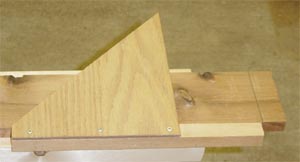A good circular saw is a "must have" tool, it will
be used for home improvement or renovations and it is the easiest
way to cut a sheet of plywood down to sizes manageable on a table saw
or bandsaw for your projects. There are many different styles and
models on the market,select a style that feels comfortable, I find
some very heavy, others have an awkward positioned handle. Purchasing
a higher quality model is a good investment, this is a tool that you
will use for a lifetime so you might as well get a good one. Don't go
cheap on the blade it is not worth having tearout on an eighty dollar
sheet of plywood an inch wide on each side of the cut just to save a few
dollars.
|
The first practical portable electric circular saw was invented by Edmond Michel and patented in 1924.
He founded the Michel Electric Handsaw Company to manufacture the saw in partnership with Joseph Sullivan.
The company name was later changed to Skilsaw Inc.
Portable circular saws in general are often referred to as Skilsaws or Skil saws. |
Types of Saws
Worm Drive

This style offers better control and accuracy, used mostly by professionals, |
Direct Drive

ThIs is the most common style, available in right and left hand models. Used by both contractors and the home handyman. |
Cordless

With the better life of L-ion batteries this type
of saw is becoming a popular choice. Extremely handy in locations where
power is not available. |
Track Saws

|
With a table saw's
accuracy, a panel saw's capacity, and a circular saw's portability, the
track saw makes precise, splinter-free cuts in almost any situation with
minimal setup.
Simply lay the
zero-clearance 59-inch track on your work-piece and plunge in with the
1,300 watt saw. The track's undermounted friction strips "grab" your
stock - no clamping necessary - while the saw slides smoothly on four
low-friction glide strips.
Available in both corded and cordless models.
Shop and Compare at Amazon.com
|
Saw
Blades
40 Tooth

The more teeth on the blade the smoother the cut. |
16 Tooth

This blade is used for fast cutting of construction grade material. |
Vinyl & Panelling

Cutting thin material requires a fine tooth blade |
Using a
Circular Saw
Always
treat these saws with respect, make sure that you have a firm hold on
the saw and the material being cut. Position the saw on the edge of the
material aligned with the cut mark, start the saw and push it straight
into the material. Be aware of where the cord is, it is easy to saw
through it. Make sure that you will not be sawing into your sawhorse or
bench. Use a sawhorse with a wide top to hold material being cut.
Cut-off Square

This
triangle shaped guide allows it to be held to the board with your left
hand with room for the saw motor to pass. Make the sides of the
triangle about 9" long out of 1/4" thick plywood, the front guide ois a
1" X 3/4" strip about 14" long. Fasten the triangle to the strip with
wood screws with the perpendicular edge of the triangle at right angles
to the top of the strip. Your first cut should cut through the strip
and the end of it is now used as a guide to position the jig.
Cutting Large sheets
Use a Sheet Rack to support the sheet, cut along a straight edge, either make one or purchase a factory made one. Cut on the back side of the sheet with a quality blade for a smoother edge.

1.
Wear eye protection when using the saw.
2. Have firm control of the saw and
material being cut.
3. Make sure the blade is sharp and
suitable for the job at hand.
4. Make sure blade guard is working,
never tie it up out of the way.
5. Check used material for nails or
other foreign objects before cutting.
6. Unplug saw before making
adjustments or changing blade.
7. Do not over-reach, always have firm
footing.
8. Allow saw to reach full RPM before
starting cut.

|










